Day 01 – AHMEDABAD
Arrive Ahmedabad. Meet our Driver/Representative. Transfer to your Hotel. Overnight at House of MG, Ahmedabad.
Day 02 – AHMEDABAD – THOL LAKE ( Aprox. 30 km / 01 Hr) – AKSARDHAM ( Aprox. 40 km / 01 hr) – MAHUDI TEMPLE ( Aprox. 10 km / 20 min)
Early Morning, Armed with packed Breakfast, proceed for Birding trip of Thol Lake. Near about mid day, proceed to visit Akshar Dham Temple near Gandhinagar and then visit famous Mahudi Temple. As time permits visit Adalaj Step Well. Overnight at House of MG, Ahmedabad.
Day 03 – AHMEDABAD
After Breakfast, proceed for full day Ahmedabad City sightseeing (Recently, Ahmedabad has been declared as a World Heritage Site).Visit to Siddi Saiyed Mosque (the cultural symbol of Ahmedabad city)
Drive to Huteesinh Jain Temple. (The oldest Jain temple in Ahmedabad famous for its carving)
Drive to Gandhi Ashram. (Also known as Sabarmati Ashram – the house where Mahatma Gandhi had stayed for 13 years and from where the historic Dandi march had begun)
Drive to Sarkhej Roza – the Acropolis of Ahmedabad – 1 hour
Proceed for shopping at Garvi Gurjari / SEWA outlet, Law garden (night market of Ahmedabad). You can also take Ahmedabad City Heritage Walk which starts late evening from House of MG. Overnight at House of MG, Ahmedabad.
Day 04 – AHMEDABAD – MT. ABU ( Aprox. 250 kms/ 05 hrs )
After Breakfast, proceed for Mt. Abu. As time permits, Mt. Abu Sightseeing. Dinner and Overnight at Jaipur House (Heritage Hotel) Mt. Abu.
Day 05 – MT ABU
Early morning, proceed for Birding around Mt. Abu. Breakfast at your Hotel. Proceed for balance Mt. Abu sightseeing visiting Delwada Jain Temple, Brahmkumari Ashram. Dinner and Overnight at Jaipur House (Heritage)
Day 06 – MT ABU – RANI KI VAV STEPWELL ( Aprox. 160 kms / 03 hrs) – MODHERA SUN TEMPLE ( Aprox. 40 kms / 01 hrs) – DASADA ( Aprox. 50 kms / 01 hrs)
After Breakfast, proceed for Dasada in Little Rann on Kutch. On way, visit the world famous 11th Century Solanki Era Step Well built by the Queen in memory of her husband. This Well is considered to be the India’s largest Step Well. Further, visit Modhera Sun Temple which is of 11th Century Era and dedicated to Sun God. A nonliving temple (no pooja/aartis). Intricate carving all around the Temple building. The place where Govt. of Gujarat organizes the Uttrardh Mahotsav every year during the third week end of January.
You can also visit Patan Town which is en route and pay visit to Patola House. A private museum created and operated byone of the last living families of the world famous Silk Patola Sarees. Proceed to Dasada arriving in time for Lunch. Dinner and Overnight at Rann Riders, Dasada.
Day 07 – DASADA
Early Breakfast and proceed for a Jeep to the Wild Ass Sanctuary of Little Rann of Kutch.
Sanctuary is home to far more than just the Wild Ass. Among the 32 other species of mammals are the Chinkara (Indian gazelle), two types of desert fox (Indian and White-footed),
Jackals, Caracals (African lynx), Nilgais(the largest antelope of Asia), Indian wolves, Blackbucks, and Striped hyenas.
Because of the Sanctuarys proximity to the Gulf of Kutch and its location on the migration routes of many bird species, it is a very important site for birds to feed and breed in. Every year, approximately 75,000 birds nest in the reserve. The Ceraneous Vulture comes from Egypt, the Common and Demoiselle Cranes arrive from Siberia, the Blue-Tailed Bee-eater visits from Europe, and the Houbara Bustard of Iran and Iraq stops over as well. All of these are commonly sighted in the Sanctuary. Also present are Sand grouses, Desert Wheatears, ten species of Lark, the White-Browed Bulbul, Indian Coursers, Stoneplovers, Shrikes, Ducks, Geese, three types of Ibis, Spoonbills, Godwits, Stints, Sandpipers, Shanks, Moorhens, Saras Cranes, both Indian flamingoes, and three species of Pelican. Latter visit Jain Temples of Shankeshwar Parshwanath Temples. Drive back to the Resort for Lunch.
Latter, late in the evening, proceed for another Jeep Safari in Little Rann of Kutch. Lunch, Dinner and Overnight at Rann Riders, Dasada.
Day 08 – DASADA – NALSAROVAR ( Aprox. 80 kms / 02 hrs ) – Kensville ( Aprox. 50 kms / 01 hrs)
After Early Breakfast, proceed to Nalsarovar. Take a boat ride in Nalsarovar
A Black Tailed Godwit gracefully descends upon the tranquil water, flutters its wings and sails on. A small, Brown and White Wader with a slightly up curved bill, the bird has traveled 3500 kms from its nesting ground in Central Europe to spend the winter at Nalsarovar in Gujarat!
Clouds upon clouds of more than 200 types of birds land in this lake having made an equally long journey to escape the harsh winter of their nesting areas. Here they find food and warmth. These migrant birds visit Nalsarovar every year from November to February. During these four months water is plentiful and fish, insects and aquatic plants abound in the lake - an ideal environment for the birds. Nalsarovar at this time is a birdwatchers delight. Proceed to your Hotel Kensville for Lunch
Proceed for another Boat Ride in the late Afternoon. The lake - Nalsarovar - and the wetlands around it were declared a bird sanctuary in 1969. Spread over 120 sq.kms, the lake and the extensive reed beds and marshes are an ideal habitat for aquatic plants and animals. The lake attracts a large variety of birds like plovers, sandpipers and stints. Latter in the evening proceed to your Hotel Kensville for Dinner and overnight.
Day 09 – Kensville – LOTHAL ( Aprox. 12 kms / 30 min.) – VELAVADAR BLACK BUCK SANCTURY ( Aprox. 80 kms / 01 hrs)
After early breakfast at Kensville, proceed to visit Harappan town of Lothal - Lothal is one of the most prominent cities of the ancient Indus valley civilization and dating from 3700 BCE and also has a Museum depicting an idea of the town with introductory write ups and maps about the site. Museum also showcases Beads, Terracotta Ornaments, Replicas of Seal and Sealings, Shell and Ivory objects, Copper and Bronze objects, tools and potteries yielded from excavations. Another Gallery at right has game objects animal and human figurines, weights, painted potteries, objects recovers from burials and ritual objects, miniature potteries.The tank at Lothal is believed to have been a dry dockyard connected by channels to the Sabarmati River Estuary. Archaeological finds suggest that Lothal s community traded with distant lands like Egypt. Proceed further to Velavadar Black Buck Sanctury and Park.
Velavadar National Park was formerly the private grassland of the Maharaja of Bhavnagar, where he would hunt Blackbucks with his famous hunting Cheetahs. Today, the Blackbuck is considerably more endangered, and so is protected from hunting, but this sanctuary is just a tiny patch of safe ground for the Blackbuck to inhabit. The Blackbuck for which the park was created lives mostly in the grasslands on the northern side. Found only in South Asia, the Blackbuck once lived all across India, but now the largest population is here, and few are found outside Gujarat. The conservation of the Blackbuck here has been a big success, however, it remains endangered due to its dependence on such a limited area to live in, but the local population has risen from a low of 200 in 1966 to around 3400 now. Given such a large population in such a small area, the chances of spotting one are very high, especially since the wide open grasslands make it easy to spot these animals leaping high over the grasses. The breeding seasons are October and February.
Other animals in the sanctuary include the Nilgai (another Indian antelope), Jackal, Wolf, Jungle Cat, and Fox, but the other main attraction is the bird life. Pelicans, Flamingos, White and painted Storks, three kinds of Cranes, many birds of prey, and the rare Stolizca’s Bushchat all live here, mostly in the southern part of the park, where all the wetlands lie. The extremely rare Lesser Florican, one of the 50 rarest birds in the world, breeds here. If you’re lucky, you might see one of its characteristic courtship displays, in which a male will jump upwards out of the grass to impress females. In the winter, thousands of Harriers arrive from Central Europe to spend the cooler months here; you can see them in the evenings coming back from feeding around the neighboring cotton fields. One in particular, the Montagu’s Harrier, is a major predator of the locust, a great problem for farms all around the area; as a safe haven for the pest-controlling Harriers, the park serves an important role in local agriculture .
Arrive in time for afternoon Jeep Safari in the National Park. Dinner and overnight at The Black Buck Lodge, Velavadar.
Day 10 – Tue. 9th Jan. 2018 – VELAVADAR – PALITANA ( Aprox. 90 kms / 02 hrs )
Proceed for early morning Birding in the National Park. After Breakfast, proceed for Palitana. Dinner and overnight at Vijay Villa Palace (Heritage), Palitana.
Day 11 – PALITANA – SASAN GIR ( Aprox. 200 kms / 05 hrs )
After Breakfast, proceed to Palitan Jain Temples on Satrunjay Mountain. Latter in the afternoon, proceed for Sasan Gir. Dinner and Overnight at Gir Birding Lodge.
Day 12 – SASAN GIR
Take early morning Game Drive by Jeep in Gir National Park. Breakfast at your hotel. Take another Safari in the late Afternoon. Lunch and Dinner and Overnight at Gir Birding Lodge.
A tapestry of dry deciduous forests, acacia scrub and grassland, fed by rivers and reservoirs, Gir is the last abode of the Asiatic lion and has a thriving population of panther (leopard), sambar, chital (spotted deer), nilgai (blue bull antelope) and wild boar. Gir is also one of the major habitats of chousingha (the world’s only four-horned antelope) and chinkara (Indian gazelle) that are hard to spot in the teak forests along the game drive trails. Among the many birds of Gir, changeable hawk eagle, crested serpent eagle, Bonneli’s eagle, shaheen peregrene falcon, laggar falcon, shikra, painted sandgrouse, quails, black-hooded and golden oriels, marshall’s and common iora, Asian paradise flycatcher, tickell’s blue, red-throated, verditer and Asian brown flycatchers, yellow-crowned, brown-capped pygmy, black-rumped flameback woodpeckers, green and blue-cheeked bee-eaters, coppersmith barbet, common, lesser pied and white-throated kingfisher, blossom-headed parakeet, hoopoe, black, ashy and white-bellied drongos, rufous treepie, large cuckoo shrike, small minivet, red-vented and white-eared bulbul, tawny-bellied, yellow-eyed, jungle and large grey babblers, grey-breasted, ashy, rufous-fronted, plain, jungle and graceful prinias, zitting cisticola, clamorous reed-warbler, booted warbler, greenish warbler, lesser and Hume’s warbler, orphean warbler and blyth’s reed warbler, are among the many birds that could be seen here. Those interested in herpetology can visit the crocodile breeding farm at Sasan.
Day 13 – SASAN GIR – SOMNATH ( Aprox. 70 kms / 2 hrs ) – PORBANDAR ( Aprox. 140 kms / 03 hrs)
Take early morning Birding tour and then after Breakfast, proceed for Somnath Temple. After Darshan at the temple, proceed for Porbandar. On arrival, check into your hotel.
In the late afternoon visit Porbandar Bird Sanctuary. It is the only sanctuary in India, which lies in the heart of city of Porbandar and is a unique example of co-existence of man and nature. It is the only bird sanctuary of the Gujarat that provides legal protection to varied species of birds which nest here. Porbandar Bird Sanctuary is the smallest bird sanctuary spread over in an area of 1 square km. The sanctuary has a lake attracting migratory birds and other birds such as teals, fowls, flamingos, ibis and curlews, Flamingos, Grebes, Pelicans, Ducks and geese, Avocets, Coots, Cormorants, Herons, Egrets, Bittern, Storks, Ibis, Spoonbill, Cranes, Whistling Teals, Gulls, Terns, Jacanas, Ruff, Red shanks, Indian roller and many other varieties of winged creatures are seen in this area.
After sunset, return back to your hotel Lords Eco Inn, Porbandar
Day 14 – PORBANDAR – DWARKA ( Aprox. 110 kms / 02 hrs )
Take early morning Birding Tour at Porbandar Bird Sanctuary. Breakfast at your hotel and proceed for Dwarka. As time permits, take a ferry boat ride to Bet Dawarika Temple which is situated on an Island. On return proceed for balance Dwarika Sightseeing. Arrive in time of evening Aarti at main Dwarika Temple. Overnight at Dwarika Hotel Lords Dwarkadhish
Day 15 – DWARKA – JAMNAGAR ( Aprox. 190 kms / 04 hrs) – KHIJADIYA BIRD SANCTUARY – ( Aprox. 20 kms / 45 Min) - JAMNAGAR
Today, after breakfast, proceed for Jamnagar. Check into your hotel freshen up and late in the afternoon, proceed for Khijadiya Bird Sanctuary. Khijadiya Bird Sanctuaryhas about 300 types of migratory birds.
The sanctuary is unique having both fresh water lakes, salt and freshwater marshlands. It is spread over an area of 6.05 km2. Before Indian independence, a check dam was built for storing the waters of river Rupen just before it enteres the sea. Over the years with fresh water of the rain and river on one side and salt water of the sea on the other side, a unique area was formed.
It is the biggest bird sanctuary in Gujarat. It is divided into 2 major parts: Part 1 and Part 2 mainly dividing salt waters and fresh waters. It is also a good place to capture a perfect sunrise and sunset.
One can find both sea and shore birds, here like the black-necked stork, great crested grebe, shikra, Indian spotted eagle, black ibis, black-winged kite, brahminy kite, pheasant-tailed jacana, great thick-knee, common greenshank, grey francolin, imperial eagle, little tern, black-tailed godwit, comb duck, common crane, common teal, dunlin, garganey, marsh harrier, northern pintail, shoveler, Eurasian wigeon, pale harrier, demoiselle, cormorants and darters. Among the other wildlife found here are blue bull, jackal, wolf, jungle cat, mongoose, Indian hare and snakes.
All the types of nests can be seen here, the ones on tree, on ground and floating nests on water. Here, varieties of ducks make floating nests. For instance, the black-necked storks, which are not found easily anywhere in India, are found here in abundance.
According to reports available least 257 to 300 types of migratory birds visit the Khijadiya Bird Sanctuary. The noted Indian ornithologist, Salim Ali when visited the sanctuary in 1984 and he reportedly sited 104 species on a single day.
After Sunset, proceed back to your Jamnagar Hotel. Overnight at Jamnagar Hotel Fortune Palace
Day 16 – DWARKA – JAMNAGAR ( Aprox. 190 kms / 04 hrs) – KHIJADIYA BIRD SANCTUARY – ( Aprox. 20 kms / 45 Min) – JAMNAGAR AIRPORT
As time permits, in the early morning proceed for 2nd visit of Khijadiya Bird Sanctuary and then proceed to Airport for your flight.
END of SERVICES.
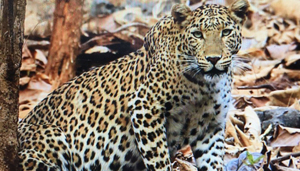 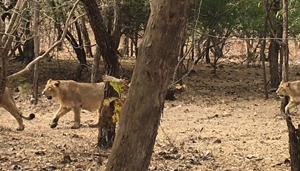 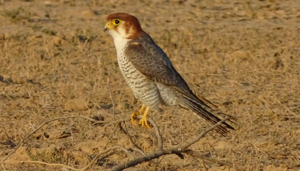 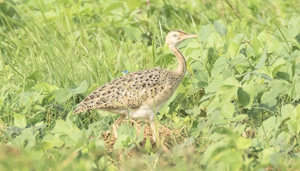 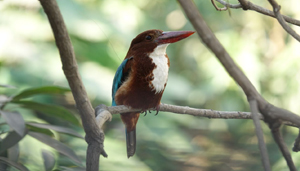 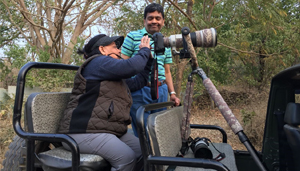
|